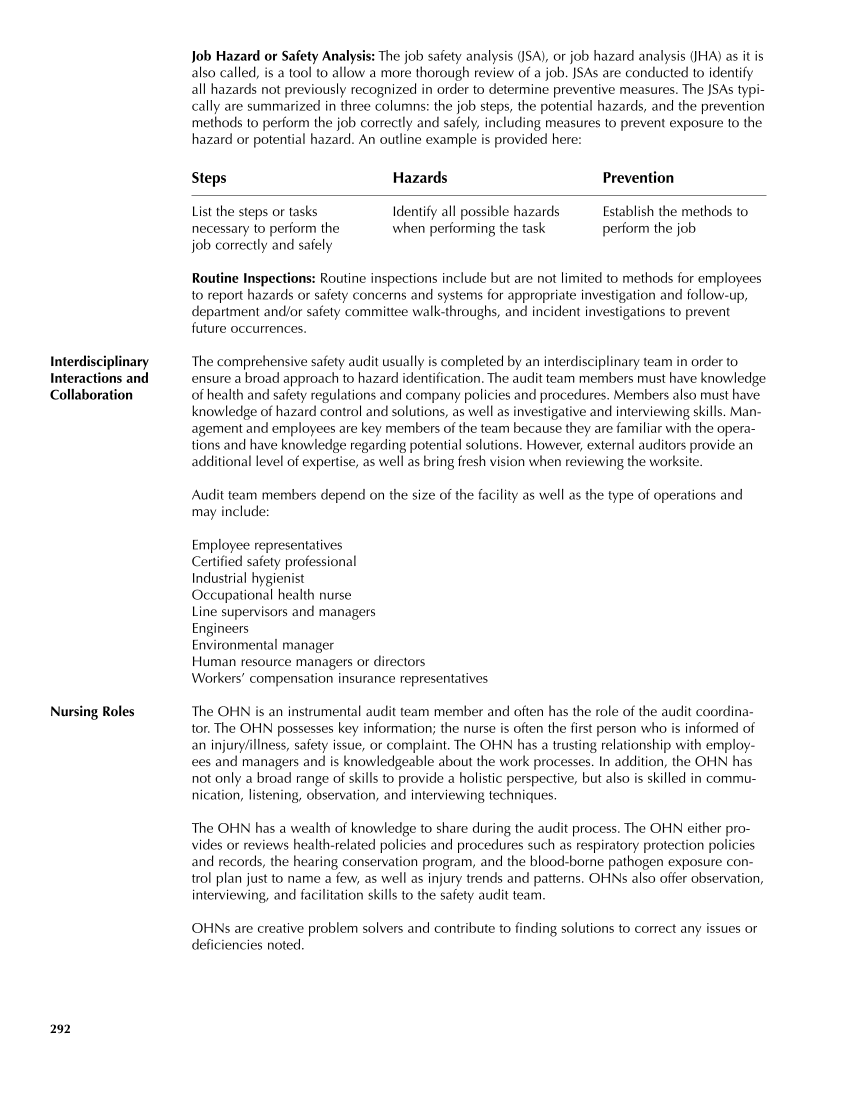Job Hazard or Safety Analysis: The job safety analysis (JSA), or job hazard analysis (JHA) as it is also called, is a tool to allow a more thorough review of a job. JSAs are conducted to identify all hazards not previously recognized in order to determine preventive measures. The JSAs typi- cally are summarized in three columns: the job steps, the potential hazards, and the prevention methods to perform the job correctly and safely, including measures to prevent exposure to the hazard or potential hazard. An outline example is provided here: Steps Hazards Prevention List the steps or tasks Identify all possible hazards Establish the methods to necessary to perform the when performing the task perform the job job correctly and safely Routine Inspections: Routine inspections include but are not limited to methods for employees to report hazards or safety concerns and systems for appropriate investigation and follow-up, department and/or safety committee walk-throughs, and incident investigations to prevent future occurrences. The comprehensive safety audit usually is completed by an interdisciplinary team in order to ensure a broad approach to hazard identification. The audit team members must have knowledge of health and safety regulations and company policies and procedures. Members also must have knowledge of hazard control and solutions, as well as investigative and interviewing skills. Man- agement and employees are key members of the team because they are familiar with the opera- tions and have knowledge regarding potential solutions. However, external auditors provide an additional level of expertise, as well as bring fresh vision when reviewing the worksite. Audit team members depend on the size of the facility as well as the type of operations and may include: Employee representatives Certified safety professional Industrial hygienist Occupational health nurse Line supervisors and managers Engineers Environmental manager Human resource managers or directors Workers’ compensation insurance representatives Nursing Roles The OHN is an instrumental audit team member and often has the role of the audit coordina- tor. The OHN possesses key information the nurse is often the first person who is informed of an injury/illness, safety issue, or complaint. The OHN has a trusting relationship with employ- ees and managers and is knowledgeable about the work processes. In addition, the OHN has not only a broad range of skills to provide a holistic perspective, but also is skilled in commu- nication, listening, observation, and interviewing techniques. The OHN has a wealth of knowledge to share during the audit process. The OHN either pro- vides or reviews health-related policies and procedures such as respiratory protection policies and records, the hearing conservation program, and the blood-borne pathogen exposure con- trol plan just to name a few, as well as injury trends and patterns. OHNs also offer observation, interviewing, and facilitation skills to the safety audit team. OHNs are creative problem solvers and contribute to finding solutions to correct any issues or deficiencies noted. 292 Interdisciplinary Interactions and Collaboration
Purchased from OEM Press by (ge corporate access). (C) 2013 OEM Health Information, Inc. All rights reserved.












































































































































































































































































































































































































































